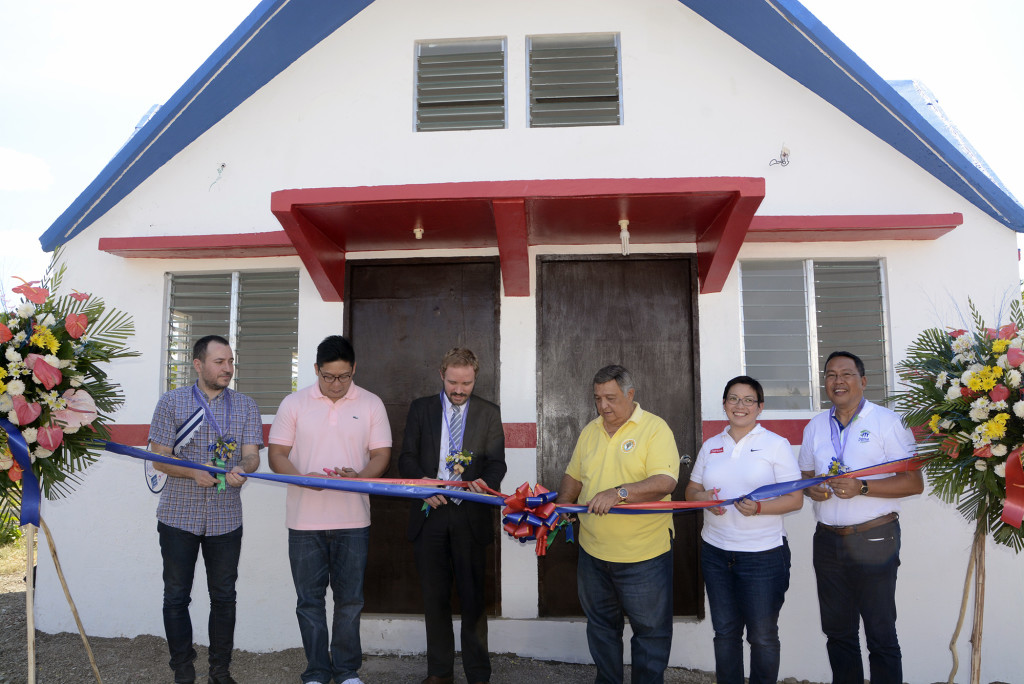
(From left) Cités-Unies France president Simoné Giovetti, Hon. Celestino “Tining” Martinez III, First councilor of the Republic of France to the Philippines Laurent Le Godec, Bogo City Mayor Hon. Celestino “Junie” Martinez Jr., Total Philippines corporate communications manager Ana Cosolluela, and Habitat for Humanity Philippines CEO Charlito S. Ayco. (CDN photo Christian Maningo)
LAST March 17, the inauguration of the first model house for Bogo City’s rehabilitation project was held in Barangay Cayang. It was attended by City Mayor Celestino “Junie” Martinez, Daanbantayan Mayor Agusto Corro and other local government officials.
Also present in the inauguration were the representatives involved in the housing project including Laurent Le Godec, First Counselor of the Republic of France, Charlito S. Ayco, CEO of Habitat for Humanity Philippines, Simoné Giovetti of Cités-Unies France and Ana Cosolluela, corporate communications manager of Total Philippines. The First Counselor noted how both the Philippines and France are partners and friends within the international community. “It is with no doubt that we had to stand by the side of the Philippines, to help the Filipino people get through this tragedy.”
The project was initiated after Typhoon Yolanda (internationally known as Typhoon Haiyan) struck most of the southern islands in the Philippines. The city of Bogo was among those badly affected with almost 4,000 residents displaced.
Under the leadership of Martinez, different programs and initiatives were implemented to address the need for a more resilient type of shelter for the people. One of the benchmark projects of the city was the Adopt-a-Barangay framework, where a team was organized to tap different NGOs and local government units for assistance in building a specific number of houses.
According to executive assistant Atty. Ahmad Clay Escolar, the initiative would not have had such strong implementation if it weren’t for the people’s support. “The people identified so much sa place that they were willing to cooperate and do their share of support.”
This same framework was introduced to France-Philippines United Action, an organization founded by French businesses which sought to take steps in sending assistance to communities affected by the typhoon. The assistance of other organizations such as Total Philippines Foundation and Habitat for Humanity for other aspects of the project were sought as well.
Cosolluela emphasized how vital the coordination of the different bodies were to the success of the project. “A lesson we learned from Typhoon Yolanda is we cannot do it alone.”
“When we came here first time to Bogo, just after the Yolanda typhoon, what we saw was a city already,” Said Giovetti. “They welcomed us and they showed us how they were capable in responding to the crisis to save their people. We were very impressed with the capacity of the city of Bogo to react.”
The initial plan is to build 46 houses successfully a year after inauguration. The area is 5,000 square meters of land donated by Mayor Martinez himself. The model house was the implementation of a design by E. Florentino. He was tasked to conceptualize a structure that can withstand natural calamities. The Hyparbolic Paraboloid design was a way of strengthening the houses by modifying the shape of the roof into a special triangle. “You can get the roof of the building and put it on the ground and it can still stand on its own,” Said Ayco. The original budget did not change and for Ayco, the unique design for this housing project will open the eyes of engineers, designers and government officials to face a reality where with the same budget there is a better way of doing things.
“Where there is support from the people, you can do a lot of development,” said Martinez. After the devastation last November 2013, the city mayor admitted to not knowing where to begin. “But when you call on the people, you ask them and they are there to respond right away, it gives you a feeling of encouragement,”
A plan to further develop 54 houses after the completion of the first 46 houses is already being discussed. In which case, once finalized, the city of Bogo is to allot another 5,000 square meters. All to ensure families can start anew in a home where they no longer have to fear for their safety whatever storm might come.

